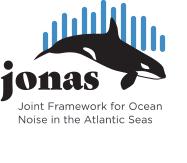 JONAS - Joint Framework for Ocean Noise in the Atlantic Seas
JONAS - Joint Framework for Ocean Noise in the Atlantic Seas JONAS - Joint Framework for Ocean Noise in the Atlantic Seas
JONAS - Joint Framework for Ocean Noise in the Atlantic SeasComments: download pdf
Ref.: JONAS Deliverable 8.3, April 2022
Executive summary:
There is a consensus that anthropogenic ocean noise has increased worldwide over the
past 50 years as a result of human maritime activities, in particular due to a significant
increase of ship traffic, and as a result of the endless quest for energy, both of fossil and
more recently also renewable origin, among others.
Efforts to assess and mitigate underwater noise resulting from anthropogenic sources
should be an endeavour of EU member states towards a higher protection of biodiversity
and marine life. Ocean sound has now been declared as an essential ocean variable (EOV)
by the Global Ocean Observation System (GOOS), which goes in line with the efforts made
by countries to protect their oceans and marine species.
JONAS project addresses the impact of underwater noise on sensitive species and the
potential threat to biodiversity in the EU North Atlantic area, which has levels of ship
traffic and marine activity among the highest in the world.
For ocean noise characterization, it is commonly accepted to separate continuous noise,
such as that produced by shipping, which is ubiquitous, indistinct and often of relatively
low level, and impulsive noise which is normally temporary, localized in space and of high
or very high intensity. Among the activities generating impulsive noise there is seismic
surveying for oil and gas exploration, and now also for offshore renewable energy installations.
Seismic surveying for oil and gas generally aims at identifying large deposits deep
into the bottom and its effects have been thoroughly reported in the literature. Instead,
the environmental effects of light seismic surveying, that aims at superficial bottom
sediment structure identification, has not been. Light seismic surveying has substantially
different characteristics, covers different areas and may, therefore, have a quite different
impact on marine life.
In the fulfilment of the requirements of task A8.3 of project JONAS, this report de-
scribes a tool for evaluating the impact of light seismic surveys in shallow water. This tool
has three components: first, a model-based methodology for determining sound pressure
level distribution due to a seismic survey in a given area; second, the evaluation of species’
habitat suitability in the same area, using the Environmental Niche Method; and third,
the combination of noise distribution and habitat suitability to provide a quantifiable and
comparable risk assessment for that species in that particular habitat.
This tool is applied in a realistic simulated survey taking place in a selected area
of the SW coast of Portugal, where environmental and biological data was available.
Final validation of the tool against experimental data could not be performed, but a
few conclusions can be drawn: as expected sound exposure levels (SEL) in the area of
the seismic survey may reach exceptionally high values relative to normally accepted
temporary / permanent threshold shifts of hearing perception of various species; acoustic
energy is strongly attenuated in shallow water but may still impact communities in a
roughly 40x40 km platform area around the seismic survey zone.
All in all, the proposed tool provides a first assessment of the shallow water seismic
survey impact with quantifiable and comparable risk outputs, which may be used for area
management decision support.